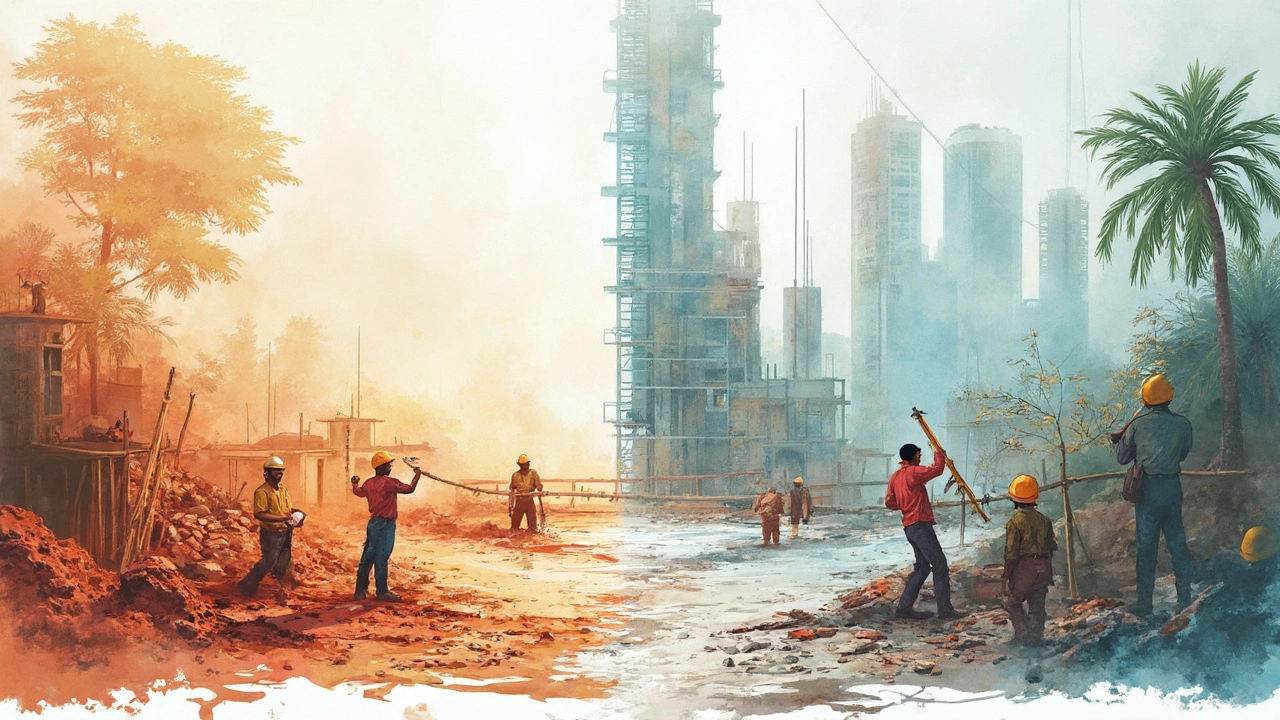Building vs Construction Materials: Know the Difference

When stepping into the world of construction, terms like 'building materials' and 'construction materials' can sound the same but play very different roles in your project. Ever wondered what makes them different? Well, you're not alone. Let's dive right in.
Building materials are the actual stuff of your construction—the bricks, wood, cement, and steel that kickstart the process from foundation to roof. These are the physical components you'll see when the job's done. But then there's construction materials. Think of this as the umbrella covering everything you might need for a successful build—tools, machinery, even safety gear that ensures a smooth operation.
Understanding this distinction might just save you from some headaches down the road. Choosing the right materials can play a huge role in your project's budget and timeline. So, what should you consider when selecting them? Stick around as we unpack this with tips and insights you won't want to miss.
- Understanding Building Materials
- The Role of Construction Materials
- Key Differences and Overlaps
- Making the Right Choices
- Tips for Selecting Quality Materials
Understanding Building Materials
When you hear the term building materials, what comes to your mind? Probably bricks, cement, or wood, right? These are the fundamental components you'll see once a structure is standing. Let's dig a bit deeper into what these materials are all about.
Common Types of Building Materials
The basic building blocks include materials like steel, which is often used for its strength and durability. Concrete is another powerhouse, excellent for foundations, walls, and even decorative elements. Wood, while a classic, offers flexibility and aesthetics cherished in residential projects.
- Steel: Often chosen for its strength and ability to withstand extreme conditions, making it a staple in large structures.
- Concrete: Known for its robust nature; it forms the backbone of modern architecture due to its versatility.
- Wood: Valued for its natural beauty and ease of use, especially in home construction.
Trends and Innovations
In the world of building materials, there's always something new happening. Recent innovations focus on sustainability and efficiency. For instance, recycled materials are gaining traction, helping reduce waste without compromising quality. Green building, using eco-friendly materials like bamboo or recycled steel, aims to lessen the environmental footprint of new constructions.
Did you know that bamboo has a tensile strength rivaling steel? It's becoming increasingly popular in areas with sustainable building practices.
Cost and Accessibility
Understanding the cost and accessibility of these materials is crucial. While steel might be pricey, it's highly durable, saving costs over time due to less maintenance. On the other hand, wood offers a more cost-effective solution for smaller projects, though it might require more upkeep in certain climates.
| Material | Avg. Cost per Sq Ft | Common Uses |
|---|---|---|
| Concrete | $3-$5 | Foundations, walls |
| Steel | $1-$3 per lb | Skyscrapers, bridges |
| Wood | $2-$5 | Residential, interiors |
Choosing the right materials involves considering factors like budget, aesthetic, and durability. Whether you're building a high-rise or a cozy home, knowing your materials can make or break your project.
The Role of Construction Materials
When embarking on any construction project, understanding the role of construction materials is crucial. These aren't just the bricks and mortar of a building; they encompass a wider range of essentials needed for the entire process to run smoothly.
Beyond Building Components
So, what falls under the category of construction materials? Let’s break it down. Aside from structural elements, this involves tools, equipment, and safety gear. Think cranes, drills, excavators—everything you need to get the job done effectively. With the right tools, workers can perform tasks more efficiently, reducing both time and cost.
Supporting Structures
And it's not just about the heavy machinery. Consider essential site materials—scaffolding, nails, adhesives, and protective coverings. Each plays a role in ensuring safety and durability throughout the build.
Safety and Regulations
Don't forget about safety gear, another vital part of construction materials. Helmets, gloves, goggles—these aren't just recommended but often legally required. Prioritizing safety helps prevent project delays and protect workers.
Planning for Success
Proper planning with construction materials can be a game-changer. An efficient supply chain ensures these materials are available when needed, minimizing wait times and keeping the project on track.
Making informed choices about your construction materials can significantly impact your project's bottom line. It's not just about what you use, but how and when you use it. Being prepared with the right gear and equipment makes all the difference.

Key Differences and Overlaps
So, let's break it down simply. When we talk about building materials, we're looking at what makes up the actual structure—think concrete blocks, wood beams, and steel rods. These are non-negotiables in erecting any building, whether it's a skyscraper or a humble shed.
On the flip side, construction materials include not just the building blocks but also the tools, equipment, and even safety gear needed to put those blocks together. They're the unsung heroes of the build—hammers, nails, cement mixers, scaffolding, and all those little things that might not be part of the building itself but are crucial to its creation.
How Do These Overlap?
It's easy to see how these terms mix and mingle. Since all building materials are technically construction materials, the lines blur. For example, a nail is used to hold wooden planks together, making it a construction material. But without nails or screws, your wood is just planks, not a wall.
A Practical Look at Their Differences
Beyond their roles, the difference often shows up in budgeting and planning. While budgeting, you'll list down specific building materials under core expenses. On the other hand, construction materials might slide under supportive tools and accessories. Budgeting for both precisely prevents runaway costs mid-project.
A common issue is underestimating these materials. Did you know that not accounting for the right tools can delay projects by up to 20%? When you tally costs later, that impacts both time and money.
| Aspect | Building Materials | Construction Materials |
|---|---|---|
| Usage | Core components of a building | Supportive tools and equipment |
| Budget Allocation | High-% of core expenses | Supporting or accessory costs |
| Example | Bricks, cement, wood | Hammers, drills, scaffolding |
By understanding and managing these differences, you're more likely to stick to your timeline and budget. So, whether you're starting your first DIY home project or heading a commercial build, always think about both sets of materials—they're the yin and yang of any successful construction venture.
Making the Right Choices
Picking the right materials can be a make-or-break decision for your project. Whether you're dealing with building materials or construction materials, knowing what to choose is like navigating a roadmap that leads to either success or disaster. But don't sweat it; we've got you covered with some solid tips.
Consider the Environment
The environment where your project takes place can dramatically affect your choice of materials. In coastal areas, where humidity and salt are factors, you'd be wise to pick corrosion-resistant materials like aluminum or treated wood. Cold climates? Insulation becomes your new best friend.
Budget Wisely
Costs can skyrocket quickly if you’re not careful. It’s crucial to strike a balance between quality and cost. High-quality construction materials may cost more upfront but can save you big bucks in future repairs and maintenance. Remember, sometimes you do get what you pay for.
Know Your Project Scale
Size matters when it comes to materials. Bigger projects may require bulk purchases, which can influence discounts and logistics. Also, smaller projects might benefit from custom solutions that fit unique requirements.
Practical Quality Checks
Here's a quick checklist to ensure you're not skimping on quality:
- Check for supplier certifications
- Read reviews and testimonials
- Inspect samples before purchase
- Confirm warranty and return policies
Data and Insights
We’re living in a data-driven world, so why not use it to your advantage? Many builders use data analytics to predict material performance and cost trends. A recent survey found that 70% of construction managers consider data analytics crucial in material selection.
| Factor | Importance Level |
|---|---|
| Environmental Conditions | High |
| Material Costs | Medium |
| Project Scale | Medium |
| Quality Checks | High |
So there you have it, an easy guide to making the right choices when it comes to your materials. It's not just about picking what looks good or is cheap. It's about ensuring quality, longevity, and performance, so you can sit back and reap the benefits of a job well done.

Tips for Selecting Quality Materials
Choosing the right building materials and construction materials can make or break your project, literally. Let’s explore some straightforward tips to ensure you’re getting the best for your buck.
Do Your Homework
Before heading to the store or calling a supplier, research is your best friend. Know what materials are specific to your project’s needs. This means understanding the climate challenges, load requirements, and even legal regulations. An informed choice saves money and time.
Lean on Experts
Got a friend or a colleague with experience in construction? Great, because getting a second opinion from someone in the know can give you insights not easily found in brochures. Plus, they might even guide you to the best local suppliers.
Consider the Environment
Going eco-friendly isn’t just a fad. Sustainable construction materials, like recycled steel or green insulation, can lower your project's carbon footprint. These choices are long-lasting and have lower maintenance costs. Look for materials with high durability and less environmental impact.
Don’t Skimp on Quality
Quality often comes at a higher price, but opting for cheap materials can cost more in repairs or replacements down the line. It's worth investing in reputable brands known for durability. Ask for samples or check past customer reviews to get a better understanding of quality.
Double-Check for Compliance
Ensuring your materials meet local building codes and standards is non-negotiable. Failing to comply can lead to project delays or even legal issues. Always verify that your selected materials come with the required certifications.
- Check weather-resistance for outdoor projects.
- Opt for fire-resistant materials in fire-prone areas.
- Ensure water-resistance for bathroom or pool areas.
Remember, better materials might edge up the budget initially but can save you from big headaches down the line. Happy building!
